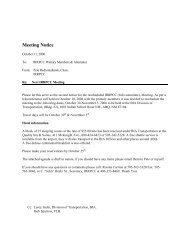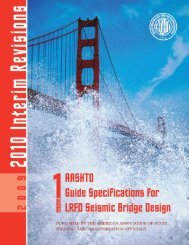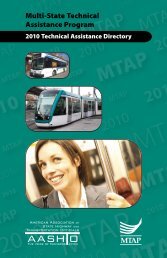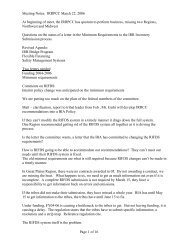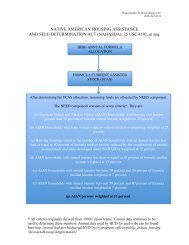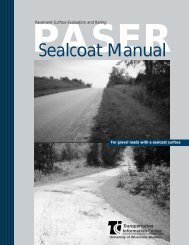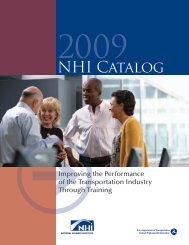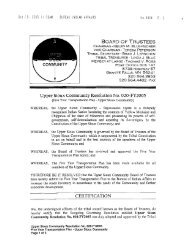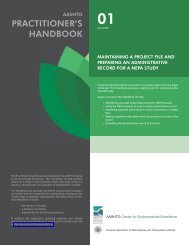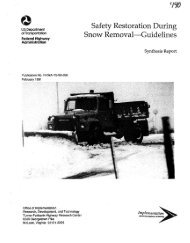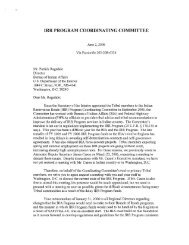Safety in Welding, Cutting, and Allied Processes
Safety in Welding, Cutting, and Allied Processes
Safety in Welding, Cutting, and Allied Processes
You also want an ePaper? Increase the reach of your titles
YUMPU automatically turns print PDFs into web optimized ePapers that Google loves.
ANSI Z49.1:1999<br />
Part II<br />
Specific <strong>Processes</strong><br />
10. Oxyfuel Gas Weld<strong>in</strong>g <strong>and</strong> Cutt<strong>in</strong>g<br />
<strong>Safety</strong><br />
10.1 Scope. This section covers safe practices for users of<br />
oxyfuel gas weld<strong>in</strong>g, cutt<strong>in</strong>g, solder<strong>in</strong>g, braz<strong>in</strong>g, <strong>and</strong> related<br />
materials <strong>and</strong> equipment. It does not cover specifications<br />
for the design <strong>and</strong> construction of such equipment,<br />
nor for the construction or <strong>in</strong>stallation of bulk gas supply<br />
or pip<strong>in</strong>g distribution systems.<br />
10.2 Term<strong>in</strong>ology<br />
10.2.1 Call Oxygen by Name. Oxygen shall be called<br />
by its proper name, oxygen, <strong>and</strong> not by the word air.<br />
10.2.2 Call Fuel Gases by Name. Fuels, fuel gases, <strong>and</strong><br />
liquid fuels shall be called by their proper names, such as,<br />
acetylene, propane, natural gas, <strong>and</strong> not by the word gas.<br />
10.3 Oxygen <strong>and</strong> Combustibles<br />
10.3.1 Keep Oxygen from Combustibles. Oxygen<br />
cyl<strong>in</strong>ders, cyl<strong>in</strong>der valves, coupl<strong>in</strong>gs, regulators, hoses,<br />
<strong>and</strong> apparatus shall be kept free from oil, grease <strong>and</strong> other<br />
flammable or explosive substances. Oxygen cyl<strong>in</strong>ders or<br />
apparatus shall not be h<strong>and</strong>led with oily h<strong>and</strong>s or gloves.<br />
10.3.2 Prohibited Uses for Oxygen. Oxygen shall not<br />
be used as a substitute for compressed air. Oxygen shall<br />
not be used <strong>in</strong> pneumatic tools, <strong>in</strong> oil preheat<strong>in</strong>g burners,<br />
to start <strong>in</strong>ternal combustion eng<strong>in</strong>es, to blow out pipel<strong>in</strong>es,<br />
to dust cloth<strong>in</strong>g or work, or to create pressure for ventilation<br />
or similar applications. Jets of oxygen shall not be<br />
permitted to strike an oily surface, greasy cloth<strong>in</strong>g, or enter<br />
fuel oil or other storage tanks.<br />
10.3.3 Oxygen Equipment. Oxygen cyl<strong>in</strong>ders, equipment,<br />
pipel<strong>in</strong>es, or apparatus shall not be used <strong>in</strong>terchangeably<br />
with any other gas.<br />
10.4 Attachments for Gas Mix<strong>in</strong>g. No device or attachment<br />
facilitat<strong>in</strong>g or permitt<strong>in</strong>g mixtures of air or oxygen<br />
with flammable gases prior to consumption, except at a<br />
burner or <strong>in</strong> a torch, shall be allowed unless approved for<br />
the purpose.<br />
10.5 Torches<br />
10.5.1 Approval. Only approved torches, as def<strong>in</strong>ed<br />
<strong>in</strong> 2.1, shall be used.<br />
10.5.2 Operation<br />
10.5.2.1 Leak Test<strong>in</strong>g Connections. Connections<br />
shall be checked for leaks after assembly <strong>and</strong> before light<strong>in</strong>g<br />
the torch. Flames shall not be used.<br />
E10.1 Note that this applies to USERS, not manufacturers<br />
of equipment (see 1.3).<br />
E10.2.1 Use of this proper name will decrease the probability<br />
of misuse.<br />
E10.2.2 Proper identity is needed to determ<strong>in</strong>e the correct<br />
hazards.<br />
E10.3.1 Oxygen will not burn, but vigorously supports<br />
<strong>and</strong> accelerates combustion, caus<strong>in</strong>g materials to burn with<br />
great <strong>in</strong>tensity. Oil or grease <strong>in</strong> the presence of oxygen<br />
may ignite readily <strong>and</strong> burn violently.<br />
E10.3.2 These prohibitions decrease the possibility of<br />
a rag<strong>in</strong>g oxygen-fed fire occurr<strong>in</strong>g. Oxygen is not flammable,<br />
but vigorously supports combustion. Oxygen can<br />
be adsorbed by cloth<strong>in</strong>g. A slight spark can result <strong>in</strong> severe<br />
burns.<br />
E10.3.3 Contam<strong>in</strong>ation of oxygen equipment with combustible<br />
substances may lead to spontaneous combustion<br />
or explosion <strong>in</strong> oxygen.<br />
E10.4 This prevents the accumulation of explosive<br />
mixtures.<br />
E10.5.1 For additional <strong>in</strong>formation on torches, see CGA<br />
E-5, Torch St<strong>and</strong>ard for Weld<strong>in</strong>g <strong>and</strong> Cutt<strong>in</strong>g.<br />
E10.5.2.1 Leak test solutions for use on oxygen connections<br />
are commercially available <strong>and</strong> are recommended.<br />
Leak test<strong>in</strong>g should be repeated after the equipment has<br />
been used <strong>in</strong> a manner that could cause leaks.<br />
23



